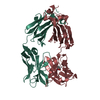+Search query
-Structure paper
| Title | Broad and potent HIV-1 neutralization by a human antibody that binds the gp41-gp120 interface. |
|---|---|
| Journal, issue, pages | Nature, Vol. 515, Issue 7525, Page 138-142, Year 2014 |
| Publish date | Nov 6, 2014 |
 Authors Authors | Jinghe Huang / Byong H Kang / Marie Pancera / Jeong Hyun Lee / Tommy Tong / Yu Feng / Hiromi Imamichi / Ivelin S Georgiev / Gwo-Yu Chuang / Aliaksandr Druz / Nicole A Doria-Rose / Leo Laub / Kwinten Sliepen / Marit J van Gils / Alba Torrents de la Peña / Ronald Derking / Per-Johan Klasse / Stephen A Migueles / Robert T Bailer / Munir Alam / Pavel Pugach / Barton F Haynes / Richard T Wyatt / Rogier W Sanders / James M Binley / Andrew B Ward / John R Mascola / Peter D Kwong / Mark Connors /   |
| PubMed Abstract | The isolation of human monoclonal antibodies is providing important insights into the specificities that underlie broad neutralization of HIV-1 (reviewed in ref. 1). Here we report a broad and ...The isolation of human monoclonal antibodies is providing important insights into the specificities that underlie broad neutralization of HIV-1 (reviewed in ref. 1). Here we report a broad and extremely potent HIV-specific monoclonal antibody, termed 35O22, which binds a novel HIV-1 envelope glycoprotein (Env) epitope. 35O22 neutralized 62% of 181 pseudoviruses with a half-maximum inhibitory concentration (IC50) <50 μg ml(-1). The median IC50 of neutralized viruses was 0.033 μg ml(-1), among the most potent thus far described. 35O22 did not bind monomeric forms of Env tested, but did bind the trimeric BG505 SOSIP.664. Mutagenesis and a reconstruction by negative-stain electron microscopy of the Fab in complex with trimer revealed that it bound to a conserved epitope, which stretched across gp120 and gp41. The specificity of 35O22 represents a novel site of vulnerability on HIV Env, which serum analysis indicates to be commonly elicited by natural infection. Binding to this new site of vulnerability may thus be an important complement to current monoclonal-antibody-based approaches to immunotherapies, prophylaxis and vaccine design. |
 External links External links |  Nature / Nature /  PubMed:25186731 / PubMed:25186731 /  PubMed Central PubMed Central |
| Methods | EM (single particle) / X-ray diffraction |
| Resolution | 1.551 - 19.0 Å |
| Structure data |  EMDB-2672:  PDB-4toy: |
| Chemicals |  ChemComp-HOH: |
| Source |
|
 Keywords Keywords | IMMUNE SYSTEM / HIV-1 / antibody / Fab / neutralizing |
 Movie
Movie Controller
Controller Structure viewers
Structure viewers About Yorodumi Papers
About Yorodumi Papers




 Human immunodeficiency virus 1
Human immunodeficiency virus 1 homo sapiens (human)
homo sapiens (human)